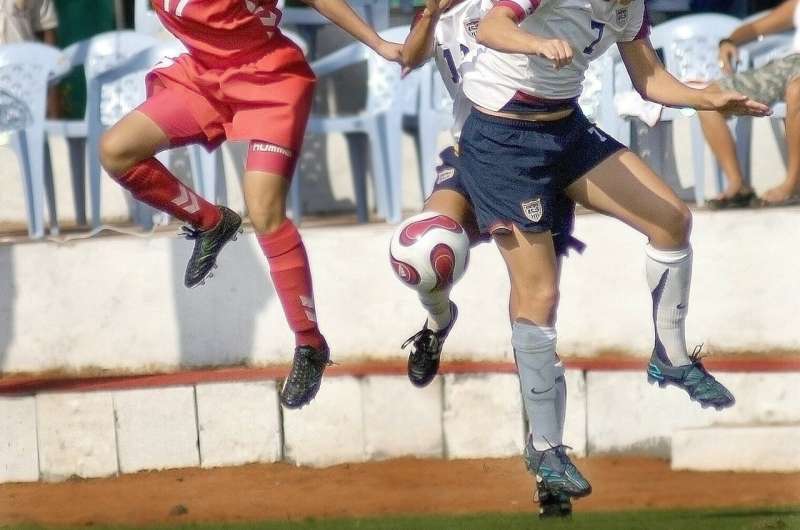Women's football may be growing in popularity, but the game is still fighting for survival

As the World Cup has vividly shown, women's football is growing in popularity and status with increasing participation, professionalization and media attention across the world. But, in our recent investigation into the women's game, we find it is still fighting for a stable footing.
We surveyed 3,000 players in 33 different countries, of whom 60 percent categorized themselves as professional. What we found was that a professional football career for women is hard to sustain in the face of low pay, a lack of contractual support, and commitments away from the pitch. There is a need for significant change to the way women footballers are supported to play for club and country alike.
Gender inequality
What we found was a paradox. On the one hand, there is a growing interest in women's football at both club and international levels, reflected in increased media coverage. The World Cup semi-final between England and the U.S. attracted an average audience of 10.3m viewers on the BBC in the UK and 7m viewers on Fox in the US.
But, on the other hand, the working conditions in the game are no way near where they should be to reflect this. Gender inequality is well documented in other sectors of the economy and our study confirms that football also suffers in equal, if not greater measure—not only from very low levels of pay but also precarious working conditions and a lack of basic support.
At elite level, the process of professionalization is underway in several countries. FIFA claim that around 30m women play the game globally, and that 5m are registered with a national association. In its current strategy document for women's football, the governing body paints a rosy picture of the current reality, describing the sport as "cutting across all boundaries in terms of society, race, religion, ethnicity and socioeconomic circumstances."
But our research found that there are significant hurdles to overcome in order to make football a secure career for women. We found that 89 percent of women footballers consider leaving the game early and were looking for opportunities outside the sport, with low pay and precarious contracts playing a significant role.
Low pay
In terms of pay, most players received salaries of less than US$1,000 a month and earnings dropped as players got older. The top five countries to "adequately pay" their players—enough to cover the expenses incurred from playing—include Germany, Uzbekistan, England, Sweden and the US. But 20 to 30 percent of players in those countries reported that they were not paid enough.
Of course, this means that female footballers are paid a fraction of their male counterparts. Research from Sporting Intelligence, a consultancy that carries out a big annual survey of global sporting salaries, found that the average salary in the English Premier League, for example, is on average 99 times higher than the top paid women counterparts.
Women footballers not only face problems around pay, but also a number of challenges around other crucial aspects of their work. These include the lack of contractual stability and agent support, as well the absence of appropriate childcare. All these expose them to insecure working conditions.
In our research, 53 percent of female footballers didn't have a written contract in place. Although it was true that some women's clubs are providing sick pay for injured players, many clubs are lagging behind.
The role of national teams
The profile of national teams and tournaments such as the World Cup account for much of the growth seen in women's football. But just over a third of players revealed that they received no payment from their national team and some even had to pay themselves to play. Countries where the large majority of players reported not being paid to play included countries with developed female football, including the US (77 percent not being paid to play) and France (62.5 percent not being paid to play).
Even in cases where players get paid, 42 percent said they did not get paid enough to cover their expenses. Countries where a significant percentage of players reported being paid adequately included Portugal (100%), Japan (67%), Italy (60%) and Germany (80%). Daily allowances were modest (US$75) and bonuses for winning a match, although only paid to less than 10 percent of players, averaged US$754, with the highest win bonus being reported as US$3,000.
Since clubs are not paying enough for women to play, there could now be a role for the national teams to provide that support in order to supplement—but not to replace—what clubs are doing. This would help more women stay in the game.
Women face an uphill struggle to maintain a career in football. Against this challenging picture, it's important that clubs, leagues and national sides explore ways to stabilize the working conditions for female footballers. They should consider the structures that will enable them to flourish—on and off the pitch—alongside their male counterparts.
While there are positives to draw from the findings, with lower levels of discrimination than the men's game, reasonable levels of medical and psychological support, and high levels of solidarity, it is clear that women's football has still got a long way to go.
Our message is for everyone involved in women's football—be it FIFA, the regional confederations, national associations, as well as public policymakers—to take women's football seriously and ensure that more women can enjoy decent, fair work conditions as they pursue their professional football careers.
Provided by The Conversation
This article is republished from The Conversation under a Creative Commons license. Read the original article.![]()





















